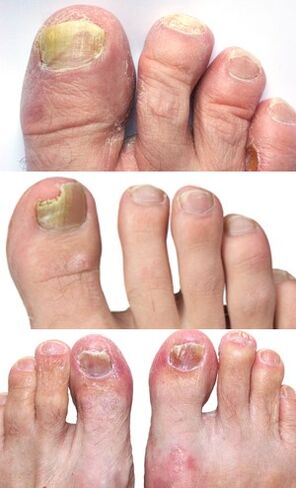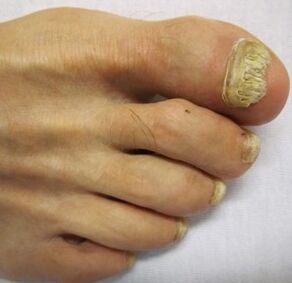The fungus can damage the entire nail, including the nail plate, nail bed, and nail root. The infection progresses slowly, leading to discoloration, thickening and bending of the nails. The accompanying signs may be skin lesions, peeling, itching, and redness on the fingers. Over time, the nails become so deformed that they interfere with the ability to wear, for example, ordinary shoes.
Most commonly, the fungus affects the toenails. The medical name is onychomycosis. It is mainly seen in the elderly and rarely seen in children. In most cases, nail mycosis develops under the influence of skin fungi, which also affect the skin. Sometimes the disease is caused by other types of fungi.
In mild cases, nail treatment may not be needed. In order to determine the exact cause of the infection and rule out other possible diseases, the dermatologist will analyze the cut nails. Nail fungus can be cured, but sometimes it takes months. Antifungal drugs come in the form of pills and nail polish. In the case of advanced nail fungus, they resort to surgery to remove the nail. There is also a laser treatment method.
Signs and symptoms of nail fungus
The most common symptoms of onychomycosis are nail discoloration and deformation. The nails can turn white, black, yellow or green. Usually, nail fungus is not of much concern at first, and in most cases there are no complications. If the infection is not carried out in time, the nail on the affected area may be painful. Toenail fungus makes it difficult to walk and wear shoes, and if the nail is affected, it may be difficult to write.
As onychomycosis develops, other symptoms may also appear, for example, the nails may become brittle, loose or peel off completely from the nail bed. If left untreated, fungal infections may spread to the skin of the fingers and the space between the fingers. White or yellow spots may appear on the nail bed, and the skin around the nail may peel off. All these changes can be seen in the photos of nail fungus.
Causes of nail fungus

The most common cause of nail damage is skin fungal infections, such as foot fungus. Usually, foot fungus grows on the skin between the toes, making it red, flaky and itchy. The fungus grows and multiplies quickly in a warm and humid environment, so wearing sports shoes or sweating feet for a long time will increase the chance of infection. About one-third of people with foot fungus develop nail rot.
Toenail fungus may be caused by infections caused by the yeast Candida, which is also the culprit of diseases such as thrush or stomatitis. If people have to wash their hands frequently or soak their hands in water for a long time at work, they are more likely to develop nail fungus. Moisture will peel off the skin at the bottom of the nail, making it easier for fungus to enter the nail. For certain diseases, the risk of developing Candida nail lesions is higher, namely:
- Diabetes or psoriasis;
- Decreased immunity, such as resistance to HIV
- The general health condition is poor.
Other factors that may increase the risk of nail fungus include:
- Wear false nails;
- Damaged nails;
- Keep biting your nails;
- Living in a warm and humid climate;
- smokes.
With age, the possibility of developing nail fungus increases. Sometimes, the fungus has no obvious cause.
Nail fungus treatment
In mild cases, treatment may not be needed. However, if left untreated, the infection may spread to other nails and the skin of toes and hands. In order to get rid of nail fungus as quickly as possible, it is important to follow simple rules: give up sweaty shoes, trim your nails and carefully monitor the hygiene of your feet.
With the use of the drug, new healthy nails will begin to grow at the bottom of the nail bed, which indicates that this treatment is helpful. Affected old nails will gradually grow back and can be trimmed within a few months. If new nails do not start to grow after 2-3 weeks of treatment, you should consult a doctor. It is impossible to stop using prescription drugs without consulting a doctor, as this may cause the infection to recur.
Foot care tips for toenail fungus
The following are tips on how to control infection during and after treatment.
- Keep your feet dry and cool, socks and shoes should let your feet "breath";
- Wear clean cotton socks and try to wear as few sports shoes as possible;
- Start treatment for foot fungus at the first signs of injury to prevent the infection from spreading to the nails.
- Trim nails correctly;
- Use separate scissors to remove the affected area of the nail to prevent the spread of infection.
- Wear the right size, low-heeled shoes and wide-toed shoes;
- Put on clean slippers in the public shower;
- If it is difficult to walk due to thick toenails, consult a dermatologist;
- It is recommended to remove old shoes that may be contaminated by fungal spores.
Nail fungus medicine

After taking the antifungal tablet, the medicine will pass through the bloodstream to reach the nail. In most cases, terbinafine and itraconazole are prescribed for nail fungus, which are very effective drugs. However, it takes months of treatment to get rid of the infection completely. If treatment is not completed, the infection may recur.
The advantage of the pills is that they will also help eliminate any related fungal infections, such as foot fungus. Possible side effects of antifungal drugs:
- headache;
- Itching;
- Decreased sense of taste;
- nausea;
- diarrhea.
Topical treatment of nail fungus
You can use anti-fungal nail polish instead of pills. It is not as effective as a pill because the drug has been applied to the nail on the affected area and needs to pass through the nail to reach the infected area. It is usually impossible to cover the entire lesion. Nail treatment on the nails can take about six months, up to a year.
To remove the affected nail plate, a paste containing 40% urea can be used. The paste can be sold over the counter without a prescription. At night, lightly apply the paste to the nail of the affected area, and then wrap it with a bandage overnight. In the morning, wash off the paste, and in the evening, follow the instructions to file off the nails, and then repeat the process. In about two weeks, the nail infected with the fungus dissolves.
This is a painless process that allows you to remove the affected nail plate and remove the fungus. It avoided months of medication and painful surgery. After the nail plate is dissolved, an anti-fungal varnish should be applied to the nail twice a week to prevent the new nail from becoming infected.
Surgery and laser treatment of onychomycosis
In the case of advanced nail fungus or severe pain, if other treatments fail, surgery to remove the nail is recommended. After the operation, new nails will grow on the removed nails over time, but this may take a year or more.
Another way to treat advanced nail fungus is laser treatment. The laser emits powerful light to kill the fungus. Research results show that this treatment is safe and effective, and some studies have reached 90% efficacy after 3 months. However, there are few data on the long-term effectiveness of this method, because most studies only follow people for 3 months. In order to get lasting results, you need to receive treatment every 3 months, up to a year. This process can be expensive.
The need for treatment and the choice of drugs should be consulted with a dermatologist. After the infection is cleared, the nails may not return to their original appearance. In these cases, despite the treatment, the nail slice still needs to be analyzed to determine whether the infection persists in the thickness of the nail.

























